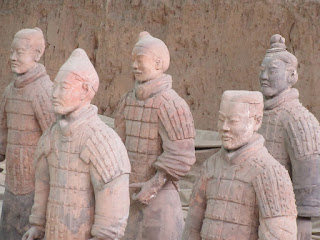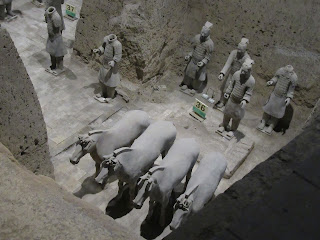 |
| Mausoleum of Han-Yang near Xian |
In an earlier blog post (June 2018) I wrote about China’s First Emperor
and the Terracotta Warriors. The funerary complex of the First Emperor of
the Qin dynasty (3th
century BC) is one of the most famous archaeological sites in the world. A
recent article featured on www.ancient-origins.net throws
some light on the celestial orientation of this and other ancient Chinese
Pyramids.
 |
| Chinese Terracotta Warriors Photo: Clare Golden |
In 246 BC, King Zhuangxiang died and Ying Zheng became King of the Qin
at just 13 years of age. Immediately after the unification of China in 221 BC,
Ying Zheng proclaimed himself Qin Shi Huang. Qin Shi Huang was fearful of death
and searched for an elixir that would make him immortal. At the same time he
commissioned the building of his mausoleum at the foot of Li Mountain, 35
kilometres from the modern city of Xi’an. He ordered the palace alchemists to
make potions which contained mercury in the hope it would extend his life,
little realising that mercury is poisonous.
 |
| Qin Shi Huang |
In death, as in life, Qin Shi Huang had everything to continue his
rule: a Terracotta Army to protect him; bronze chariots for travelling;
terracotta acrobats for his entertainment; an arsenal storing stone armour,
stables full of horse skeletons, and his concubines buried alive with him.
The unexcavated tomb of the First Emperor, Qin Shi Huang, lies beneath
a huge, artificial hill of rammed earth. This hill has a square shape measuring
350 meters at the base and is over 40 meters high.
Astronomy and
Feng Shui of the Chinese Burials
A new study forming part of a wide-ranging program of research on the
role of astronomy and of the traditional doctrine of feng shui in the Chinese imperial necropolises has recently
been published.
Egyptian pyramids are oriented to the four main points of the compass -
north, south, east, and west by virtue of the very strong bonds of the funerary
religion of the Egyptian pharaohs with the sky and with the circumpolar stars.
A star that can be viewed from specific latitude on Earth that is visible for
an entire night and for every night of the year is called a circumpolar star.
Split Alignment
Chinese monuments can be classified according to two groups. One such group contains monuments oriented to
the cardinal points (N-S-E-W), as expected. In the second group there are
important deviations from the true north, all of comparable direction, and all
oriented to the west of north.
 |
| Chinese Terracotta Warriors with Horses Photo: Clare Golden |
Researchers believe that the emperors who built the pyramids of the
second group did not want to point to the north celestial pole, which at the
time did not correspond to any star. Instead, they wanted the pyramid to point
to the star Polaris to which the pole would be pointed in the future.
Researchers point to a phenomenon known as the ‘precession of the
earth's axis’, which slowly but constantly moves the position in the sky in
which the earth's axis points, and therefore the celestial pole. The Chinese
astronomers were almost certainly aware of this. The Earth's axis rotates (precesses) just as a spinning top
does. The period of precession is
about 26,000 years. Therefore, the North Celestial Pole will not always point
towards the same starfield. Precession is
caused by the gravitational pull of the Sun and the Moon on the Earth.
Today we are used to identifying the north celestial pole with Polaris
or the North Star although the correspondence is not perfect. At the time of
the Han emperors the pole was still far from Polaris, and with a distance in
degrees approximately equal to the deviation of the Chinese pyramids from the
geographic north.
Even though Polaris is
the North Star today,
this has not always been
the case. The place in
the sky that the Earth's north pole points at changes slowly over time. In 3000
BC, a faint star called Thuban in the constellation of Draco was the North Star and astronomers calculate
that in about 13,000 years from
now the precession of the rotation axis will mean that the bright star Vega
will be the North Star.
 |
| Map of the Growth of Qin |
The Qin Dynasty was short-lived. Within five years of the First
Emperor’s death, peasant rebels had stormed Xianyang and one of the leaders,
Liu Bang, had taken the throne and established the Han Dynasty (206 BC – AD
220).
The Han Dynasty lasted for more than 400 years and rivalled the almost
contemporary but smaller Roman Empire in the west. A census in AD 2 records
almost 60 million people in the Chinese Empire.
For further information see:





No comments:
Post a Comment